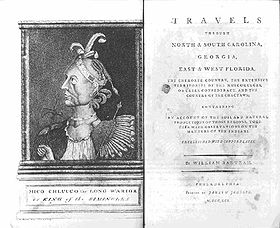Bartram's Travels

Bartram's Travels is the short title of naturalist
The book's full title is Travels through North and South Carolina, Georgia, East and West Florida, the Cherokee Country, the Extensive Territories of the Muscogulges or Creek Confederacy, and the Country of the Chactaws. Containing an Account of the Soil and Natural Productions of Those Regions; Together with Observations on the Manners of the Indians.
The travels
William Bartram was a
Between 1774 and 1776 Bartram sent 59 drawings and 209 dried plant specimens to Fothergill, along with a two-part report of his travels. This report was not published during Bartram's lifetime and is not to be confused with the book.
The present-day Bartram Trail system, including the Bartram Canoe Trail, commemorates William Bartram’s journey by marking segments of his approximate route in Alabama, Florida, Georgia, North Carolina, and South Carolina.
Publication history
Bartram remained in Philadelphia during the Revolutionary War. There he wrote the manuscript of his book while restoring the
The book was deposited for
Bartram expressed dissatisfaction with the first edition of his book, which contained many errors, especially in the spelling of scientific names. He enclosed a list of 28
Significance
Bartram's Travels is significant as a scientific work, as a historical source concerning
Early readers were sometimes skeptical about the accuracy of Bartram's description of what was then an exotic part of the world. But as the regions became more familiar to scientists in the nineteenth century, Bartram's accuracy was confirmed. He is considered the scientific discoverer of several plant species, including the
Critics were often skeptical of Bartram's sympathetic description of the
Indians, which challenged presumptions that the Indians were primitive "savages." In addition to the Travels Bartram wrote other documents concerning his impressions of the southern Indians and the necessity of a humane public policy toward them.Among Bartram's admirers in England were the poets
European editions
Bartram's Travels appeared in Europe when an edition was published in London in 1792, and another in Dublin in 1793. Also in 1793, the Travels appeared in German as William Bartram's Reisen, translated by Eberhard August Wilhelm von Zimmermann.[9] The book was published almost simultaneously in Berlin and Vienna.
A second London edition of the Travels appeared in 1794, and this is the edition owned by Wordsworth and Coleridge. In the same year, Jan David Pasteur's Dutch translation was published in Haarlem.[10] It was published again in 1797.
A French translation by Pierre Vincent Benoist, Voyage dans le parties sud de l'Amérique septentrionale, appeared in 1799 in Paris, followed by a second edition in 1801.[11]
Modern editions
- The Travels of William Bartram: Naturalist's Edition. Edited by Francis Harper. New Haven, Conn.: Yale University Press, 1958. Reprint, Athens: University of Georgia Press, 1998. ISBN 0-8203-2027-7
- Travels and Other Writings. Thomas P. Slaughter, editor. New York: Library of America, 1996. ISBN 978-1-883011-11-6
- Travels through North and South Carolina, Georgia, East and West Florida, the Cherokee Country.... Introduction by James Dickey. New York: Viking Penguin, 1996.
- Travels through North and South Carolina, Georgia, East and West Florida: A facsimile of the 1792 London edition embellished with its nine original plates. Introduction by Gordon DeWolf. Charlottesville: University of Virginia Press, 1980.
- Travels. Introduction by ISBN 0-486-20013-2
References
- "Chronology," in Travels and Other Writings, ed. Thomas P. Slaughter, 599–604.
- Francis Harper, "Introduction," in The Travels of William Bartram: Naturalist's Edition, ed. Francis Harper, xvi–xxxv.
Notes
- ^ Bartram, William (1791). Travels through North and South Carolina, Georgia, East and West Florida, the Cherokee Country, the Extensive Territories of the Muscogulges or Creek Confederacy, and the Country of the Chactaws. Containing an Account of the Soil and Natural Productions of Those Regions; Together with Observations on the Manners of the Indians. Philadelphia: James & Johnson. Retrieved August 25, 2018 – via The Library of Congress.
- JSTOR 2709478.
- ^ Francis Harper, "Introduction," in The Travels of William Bartram: Naturalist's Edition, xxi.
- ^ Harper, "Introduction," xxii–xxiii.
- ^ a b Harper, "Introduction," xxiii.
- ISBN 978-0-8122-0619-7.
- ^ Harper, "Introduction," xxi–xxvii.
- ^ "Specimens of the Table Talk of Samuel Taylor Coleridge".
- ^ William Bartram, Reisen durch Nord- und Süd-Karolina, Georgien, Ost- und West-Florida, das Gebiet der Tscherokesen, Krihks und Tschaktahs, nebst umständlichen Nachrichten von den Einwohnern, dem Boden und den Naturprodukten dieser wenig bekannten grossen Länder, ed. E.A.W. von Zimmermann (Berlin: In der Vossischen Buchhandlung, 1793). WorldCat
- ^ William Bartram, Reizen door Noord- en Zuid-Carolina, Georgia, Oost- en West-Florida; de landen der Cherokees, der Muscogulges, of het Creek bondgenootschap en het land der Chactaws, trans. by Jan David Pasteur (Haarlem: F. Bohn, 1794). WorldCat
- ^ William Bartram, Voyage dans les parties sud de l'Amérique septentrionale; savoir: les Carolines septentrionale et méridionale, la Georgie, les Florides orientale et occidentale, le pays des Cherokées, le vaste territoires des Muscogulges ou de la confédération Creek, et le pays des Chactaws, ed. Pierre Vincent Benoist (Paris: Carteret et Brosson, an VII [1799]). WorldCat
External links
- Bartram's Travels at Project Gutenberg
- Bartram's Travels, The Internet Archive
- Bartram's Travels online, University of North Carolina Library
- Bartram Trail Conference
